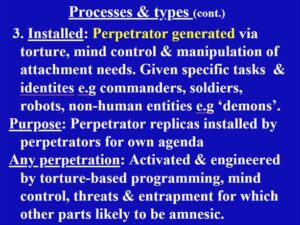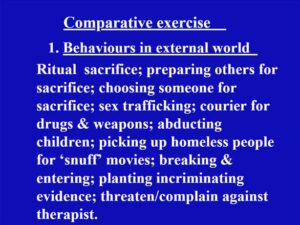Current Titles:
Attachment-based Psychoanalytic Psychotherapist | Private practice
Member and Training Supervisor at The John Bowlby Centre
Professional Experience:
Council for Psychoanalysis and Jungian Analysis College (CPJAC)
Member of the International Society for the Study of Trauma and Dissociation (ISSTD)
Member of The ISSTD's Ritual Abuse Mind Control Organized Abuse Special Interest Group (RAMCOA SIG)
Founding member of European Society for Trauma and Dissociation - United Kingdom (ESTD-UK)
Notable Publications:
Child Sexual Abuse: Whose Problem? | 1st edition 1991, revised 2nd edition, 2018
Creative responses to child sexual abuse: challenges and dilemmas | 2001

Why She’s On Our Radar
Sue Richardson claims a key role in the 1987 Cleveland child abuse scandal, a widely discredited scandal that saw 121 children, some ripped from their homes in the middle of the night, placed in foster homes and hospitals. The 121 diagnoses were made by two pediatricians at a Middlesbrough hospital, Marietta Higgs and Geoffrey Wyatt, using the later-discredited diagnostic of reflex anal dilation. RAD as a clinical marker for sexual abuse is now considered discredited. As a result, 94 of the 121 children were returned to their homes.
Presenting at the ESTD 2019 Conference, Sue Richardson’s presentation Perpetrator- imitating personalities: A framework for understanding & practice offers an alarming insight into her beliefs as she describes various “perpetrator personalities,” evil parts of a so-called fragmented self that present externally to perform various Satanic rituals and crime. According to her, these personalities can be anything-- even taking the form of a demon or robot.


In an ESTD document compiled by Sue Richardson in 2019 aimed at clinicians “new to working with clients/patients who experience distressing levels of dissociation,” she deems publications by fellow conspiracists Alison Miller and Bessel van der Kolk “essential reading.” Perhaps unsurprisingly, a direct link to Ellen Lacter’s website End Ritual Abuse is also provided.
In her own words:
"Although there is still not a complete consensus on this matter the current evidence-based guidelines (RCPCH, 2015) conclude that the so-called 'controversial' sign of anal abuse used in Cleveland is one of the most statistically significant findings that can be relied upon in the diagnosis..."
“I began to see the potential significance in what some of my clients drew, such as an all-seeing eye or an inverted crucifix, or spoke of, such as memories of robed figures and chanting. One of these clients had a vivid implicit memory of what presented as ritual abuse ceremonies, which she was able to draw very clearly but without any conscious memory of them at all.”
“In this case, professionals were at first commended by the High Court for protecting a group of children from sadistic abuse, but were subsequently derided in the media and elsewhere for believing the children’s further disclosures, which were replete with indicators of satanic ritual abuse.These colleagues drew attention to the possible significance of some of the drawings published in our account of Cleveland’s children. For example, a child who was seen by a clinical psychologist drew her abuser dressed as a devil figure (Richardson & Bacon, 1991, p. 117). While it has never been established whether or not this child or any of the children in Cleveland had suffered ritual abuse, some professionals are now of the opinion that this may have been a factor in the crisis.”
“Perpetrators are experts in attachment theory and know only too well how to subvert the biologically based code to facilitate abuse. In ritual abuse, mind control, and organised abuse (RAMCOA) victims are severely traumatized by the use of torture and other methods such as hypnosis to deliberately engender dissociation.”
“Perpetrators may attempt to induce fear in us, most often via the client passing on alleged threats to the therapist’s safety, or by threatening to make a complaint. There are indications that as therapists get better at working with RAMCOA, complaints against therapists and supervisors at the instigation of perpetrators are becoming part of this phenomenon.”
